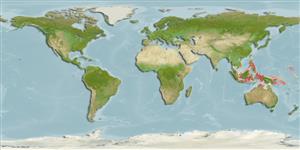分類 / Names
俗名 | 同種異名 | Catalog of Fishes(屬, 種) | ITIS | CoL | WoRMS | Cloffa
Teleostei >
Syngnathiformes (Pipefishes and seahorses)
海龍目 (Pipefishes and seahorses) >
Syngnathidae (Pipefishes and seahorses)
海龍科 (Pipefishes and seahorses) > Syngnathinae
Etymology: Apterygocampus: Greek, apterygos = without fins + Greek, kampe = curved (Ref. 45335).
More on author: Weber.
Environment: milieu / climate zone / depth range / distribution range
生態學
海洋 居於水底的; 深度上下限 3 - 10 m (Ref. 90102). 熱帶
Western Central Pacific: Indonesia, the Philippines and Papua New Guinea.
中西太平洋: 印尼,菲律賓與巴布亞新幾內亞。
大小 / 重量 / 年齡
Maturity: Lm ? range ? - ? cm
Max length : 3.0 cm SL 雄魚/尚未辨別雌雄; (Ref. 48635)
簡短描述
型態特徵 | 形態測量圖
背的軟條 (總數): 17-20. Holotype from 'reef', a brooding male lacks dorsal and pectoral fins, while those fins present in its pouch-larvae. Planktonic specimens at similar size of adults have dorsal fin and pectoral fins. The female looks much like female Acentronura, but have a moderately large caudal fin. The pouch of the male holotype is sac-like, also similar to Acentronura (Ref. 48635).
來自 '礁' 的 Holotype, 一個繁殖期的雄魚缺乏背部的與胸鰭, 然而那些鰭出現在它的小袋-仔魚。 浮游生物標本在相似的成魚大小有背鰭與胸鰭。 母魚看起來很像母魚 Acentronura, 但是有一個普通大的尾鰭。 雄魚 holotype 的小袋是囊狀的, 也類似 Acentronura.(參考文獻 48635)
Specimens taken at the surface with nightlight and dipnet. May also be found on shallow mudflats with sparse seagrasses. Ovoviviparous (Ref. 205). The male carries the eggs in a brood pouch which is found under the tail (Ref. 205). Found in association with Briareum soft corals (Ref 90102).
標本採自了表面使用燈光誘捕與手抄網。 可能也被發現於水淺的泥灘有稀疏的海草之上。 卵胎生的.(參考文獻 205) 雄魚帶卵在一個孵卵袋是在尾部下面發現.(參考文獻 205)
Life cycle and mating behavior
成熟度 | 繁殖 | 產卵場 | 卵 | 孕卵數 | 仔魚
Male carries the eggs in a brood pouch (Ref. 205).中西太平洋: 印尼,菲律賓與巴布亞新幾內亞。
Dawson, C.E., 1985. Indo-Pacific pipefishes (Red Sea to the Americas). The Gulf Coast Research Laboratory Ocean Springs, Mississippi, USA. (Ref. 5316)
人類使用
更多資訊
年龄/大小成長長度-重量長度-長度長度-頻率形態測量圖型態特徵仔魚稚魚動力學入添量豐度BRUVS
參考文獻養殖養殖資訊品種遺傳學Electrophoreses遺傳率疾病加工NutrientsMass conversion
合作者照片Stamps, Coins Misc.聲音神經毒速度泳型鰓區Otoliths腦重體重比眼睛色素
工具
特別的報告
下載 XML
網路資源
Estimates based on models
Preferred temperature (Ref.
123201): 28.5 - 29.3, mean 28.8 °C (based on 509 cells).
Phylogenetic diversity index (Ref.
82804): PD
50 = 1.0000 [Uniqueness, from 0.5 = low to 2.0 = high].
Bayesian length-weight: a=0.00037 (0.00016 - 0.00085), b=3.18 (2.99 - 3.37), in cm total length, based on LWR estimates for this (Sub)family-body shape (Ref.
93245).
營養階層 (Ref.
69278): 3.1 ±0.4 se; based on size and trophs of closest relatives
回復力 (Ref.
120179): 高度, 族群倍增時間少於 15個月 (Preliminary K or Fecundity.).
Fishing Vulnerability (Ref.
59153): Low vulnerability (10 of 100).
